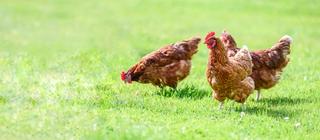Should You Pasture Your Birds?
Or does this disrupt careful feed balances?


Every animal has the same basic needs for water, energy, amino acids, vitamins, and minerals.
In a commercial setting, it is fairly straightforward to supply close to the exact needs of the bird without deficiency or excess waste. We know the exact nutrient requirements of commercial strains via primary breeder, university, and private research.
Most situations are similar in terms of environment, stocking density, age of birds, etc. But in a homesteader’s flock, we may have heritage breeds, different ages, some that have been bred for nearly commercial-level egg production or for dual-purpose egg and meat production.
So we have a moving target that is different not just between farms, but often within a flock.
On top of that, we have other sources of nutrition (treats, pasture, forage), and while we may not be able to completely or accurately account for them, we should at least be aware of how they might affect daily nutrient intake.
Good layer feed is formulated to contain a balance of all nutrients for the purpose or stage of life it’s designed for.
Any other source of nutrition will reduce the amount of feed consumed, because hens will consume feed to meet their energy and amino acid needs.
That means if something like a treat has calories, but doesn’t also have a perfect balance of vitamins, minerals, or other nutrients, we run the risk of a bird not consuming all the nutrients that she needs for maximum production, health, etc.
Predicting pasture benefits
Foraging is tricky because no two pastures are the same, especially across states or countries. While in one area there may be a particularly rich source of protein or energy available (which could be from plant sources or bugs, worms, etc.) others may be relatively devoid of good things to eat and only serve to dilute—rather than supplement—layer feed.
That said, there are great benefits to pasture access, including:
Increased vitamin E and Omega-3 fatty acid intake and egg deposition.
Increased consumption of carotenoids and flavonoids from forage intake.
Increased leg bone strength.
Reduction of problematic behaviors, such as feather pecking.
Preference for certain substrates to facilitate non-nutritive behaviors, e.g. peat moss for dust bathing.
Variable foraging results
Studies have demonstrated that depending on the type of forage available, hens can consume an appreciable amount of energy and amino acids to supplement their feed. However, in one study hens fed a diet deficient in energy and amino acids were not able to fully compensate for the lack of nutrients by foraging.
In contrast, organically-reared hens fed only whole wheat were able to compensate by foraging and had similar egg production to hens fed a layer feed, but with significantly higher amounts of grit stone and soil found in their crops. Adaptation in the latter example took approximately 6 to 8 weeks, which may be related to changes in gizzard size and function.
It's not surprising that there are contrasting results from studies evaluating the effects of foraging on hen health and egg production.
What about the bird?
The differences between breeds and available forage in different situations is too great for a one-size-fits-all answer.
However, we can be pretty confident that our hens (and us) will benefit from certain effects of foraging such as vitamin E, carotenoid, and flavonoid intake.
Grass is rich in carotenoid pigments such as β-carotene, which in addition to lending a beautiful, rich color to egg yolks, is a pro-vitamin precursor to vitamin A.
Additionally, flavonoids are plant-secondary metabolites that are potent antioxidant and anti-inflammatory molecules that have tremendous health benefits.
Research also demonstrates that hens choose forage types depending on what they are fed as well as what is available.
For instance, hens fed a complete layer diet preferred clover, while those fed whole wheat and oyster shell preferred grass, even though both groups consumed clover and grass. In the same study, eggs from hens fed the layer diet with access to grass-clover pasture had lower sensory scores than eggs from hens fed the layer diet in an indoor-only production system or those fed whole wheat and oyster shell with pasture access.
Another study with dairy cows demonstrated a negative effect of red clover on sensory quality of milk products, presumably due to increased fatty acid oxidation and subsequent generation of off-flavors.
Think of the whole bird
So to make sure that your hens always receive the nutrition they need, the best course of action is to feed a premium complete layer feed with ample amounts of antioxidants.
These include vitamins as well as things such as citrus, oregano, thyme, cinnamon or other essential oils and extracts.
That way all the behavioral, nutritional, and other benefits of pasture-raised egg production can be obtained while maximizing the health of your hens and quality of their eggs.
About the author
Dr. Curran Gehring is the Nutritionist at Tucker Milling LLC in Guntersville, Ala. For more than eight years, he has formulated diets and develops products for all species, including time as the consulting nutritionist for a Vital Farms pasture-raised poultry partner. He has been at Tucker Milling for five years and has a passion for creating the best poultry and livestock feed on the market.
August 24, 2023
Tags:Healthy Flock

Chicken Whisperer is part of the Catalyst Communications Network publication family.












